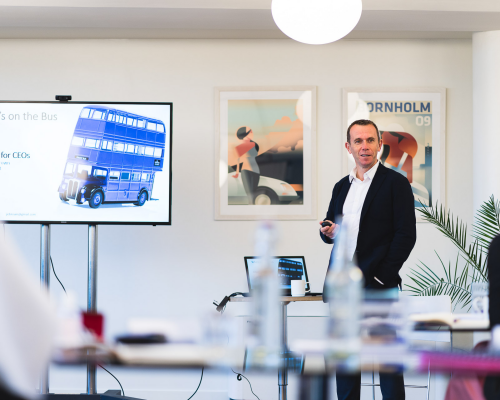Have you ever wanted to ask a leading CEO some key questions on how they got to where they are and what key insights would they give to new or up and coming CEOs?
Well, we already did! Our research report Stepping Up to CEO looked at what could be done to prepare individuals for the most unique and demanding role of Chief Executive.
With no single ‘CEO pathway’ to the top, the preparation taken varies depending on context, competencies, and career choices. That said, 93% of the CEOs and Chairs we spoke to agreed that prospective CEOs require more preparation specific to the role, stating that its unique nature contributes to the difficulty in preparing for it:
“Everything you’ve ever done prepares you for it, but nothing you’ve ever done prepares you for it…”
So, what makes up the secret sauce of a successful transition into CEO?
Why CEOs Fail
Firstly, an understanding of the possible derailers to a new CEO and how to avoid them. Here’s five, garnered from the School for CEOs Faculty experiences, that you should pay attention to:
- Don’t jump to decisions too early – it’s tempting to come up with all the answers on the first day. Even though your team may want this, you don’t have to. Make your colleagues present and justify their recommendations; ask “What would you do?”. Stand back and give others responsibility.
The risk here is being eager to appear ‘decisive’ and that you create a culture of poor decision-making.
- Don’t do nothing - it can all seem overwhelming, there will be lots of vested interests trying to preserve their position. You will need the courage to face down the natural inertia of the organisation.
There’s a risk that by trying to keep all interests onside, you don’t make the moves you need to - you must act!
- Don’t over complicate – you will need to keep the language you use simple. Focus on no more than three key aspects. Ensure you demonstrate that you have the Board/Chair’s support and hold your Executive accountable early on. Early communications with the broader organisation are essential both virtual and face to face. Display humility - don’t pretend to have all the answers.
You risk losing your stakeholders by complicating messages or making grandiose commitments. Take your time and stick to your messages!
- Don’t lose your balance – there are common themes through any CEO tenure:
- Taking time to get decisions right versus procrastinating
- Being consultative versus directive versus indecisive
- Setting direction versus riding roughshod
- Being approachable versus distant versus reserved
- Demonstrating humility versus being humble
- Moving at pace versus wheels come off
- Gut versus data.
The risk is that you lean too much in one direction. Flexibility is key!
- Don’t lose touch with yourself - don’t let the organisation become you, or vice versa. Have the appropriate level of distance and objectivity – you can’t be everyone’s friend. Everyone will want a slice of your time and want to impress – don’t be overwhelmed. Keep a grip on reality and develop your self-awareness and humility.
Don’t get carried away and forget you are still an individual. Showing you’re human is important – be yourself!
New CEO Stakeholder Engagement
Stakeholder engagement is one of the most difficult aspects of the CEO role. The unique demands of the role can derail leaders both daring or diligent, collaborative, or single-minded.
A CEO's success is heavily dependent on the relationships they build with stakeholders. Prioritising relationship-building before and after stepping into the CEO role can lead to a smoother transition and greater support.
From the moment a CEO steps into their role, they must recognise the importance of continuously engaging with their stakeholders. This means actively listening, seeking feedback, and maintaining open lines of communication.
Recognising who is impacted by your decisions and their respective interests and expectations is essential. Depending on the type of organisation, your stakeholders include employees, customers, suppliers, investors, regulators, and local communities. For family-owned and third-sector organisations there will be founders, owners, trustees and members/volunteers too.
Each group has its interests and expectations that need to be considered when making strategic choices. Meet them to understand their expectations and concerns. This will help in aligning the agenda with the interests of those who have a stake in the company's success.
Don’t forget your key relationships. For listed and private equity-owned businesses, the first of these is the Chair. They’re not your boss, but be prepared to wrestle for control. You must be seen to work closely together as a team. Your relationship is one of mutual trust. Don't do what they want just because they want you to do it; there can only be one CEO. Second, the Board; listen to what they have to say, make sure they feel consulted. Third, your CFO – it is vital they are your supporter. Next, the Executive team, remember, you’re setting the tone for the organisation as well as leading the team and finally, Advisors. Pick good ones and remember they’re only advisors.
The New CEO's Agenda
As CEO, you're setting a course for the company's future, and it's your responsibility to lead with vision, clarity, and commitment to the organisation's success. It’s essential to set the agenda early into your appointment.
Start by gaining a clear understanding of the organisation's current position and the challenges it faces. This involves listening to key stakeholders – see above - and gathering diverse perspectives to inform your strategic priorities. Here are nine steps to success:
1. Assess the current situation - conduct a thorough assessment of the company's strengths, weaknesses, opportunities, and threats (SWOT analysis).
2. Define clear objectives - based on the assessment and stakeholder input, define clear and measurable objectives that align with the company's vision and mission.
3. Prioritise initiatives - it's important to focus on what will drive the most value for the company and address the most pressing challenges.
4. Communicate the agenda - clearly and effectively communicate the agenda to the entire organisation. Transparency about the direction and priorities will help garner support and ensure everyone is working towards the same goals.
5. Implement with flexibility - it's important to remain flexible and responsive to feedback. The business environment is dynamic, and the ability to adapt is key to success.
6. Monitor progress - regularly review the progress against the objectives and adjust as necessary. Don’t forget to celebrate successes and learn from setbacks.
7. Build a supportive culture - encourage a culture of open communication, collaboration, and continuous improvement. This will help in executing the agenda and overcome resistance to change.
8. Build your top team – once you’ve assessed what you need you’ll be able to come to some early decisions as to who you need on your top team.
9. Develop a culture of inclusive leadership – it’s imperative that you set the tone from the top. Identify the key culture drivers in the organisation and embed inclusive leadership into your company culture.
New CEO Training
Have you ever wanted to ask a leading CEO some key questions on how they got to where they are and what key insights would they give to new or up and coming CEOs?
This and many of your questions can be answered at The Vital Few - an immersive two-day programme for New CEOs. You will hear personal insights from industry leaders on their journey to successfully navigate the CEO landscape.
The emphasis of the programme is on practical lessons for immediate use, and a variety of experienced business leaders and experts from our Faculty join the programme to share real life experiences and learnings in an intimate Chatham House setting.





